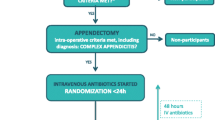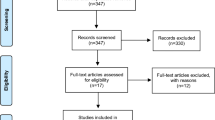Abstract
The suitable duration of antibiotic use following appendectomy for advanced appendicitis in children is still debated. A systematic review was performed, including published experimental and observational data of antibiotic use in children who had undergone appendectomy for advanced appendicitis. Data were extracted and analyzed according to predefined criteria. Twenty-eight studies were selected that included 2,284 patients. There was no consistency among the protocols regarding length of antibiotic use, discharge criteria, or use of home antibiotics following discharge. Limiting duration of antibiotic use to3 days did not appear to be associated with higher rates of intraabdominal abscess or wound infection. In the absence of higher-level evidence, shortening of antibiotic regimens following surgery for pediatric complicated appendicitis appears to be safe.

Similar content being viewed by others
References
Hale DA, Molloy M, Pearl RH, et al. (1997) Appendectomy: a contemporary appraisal. Ann Surg 225:252–261
Pearl RH, Hale DA, Molloy M, et al. (1995) Pediatric appendectomy. J Pediatr Surg 30:173–178
Lau WY, Fan ST, Yip WC, et al. (1987) Acute appendicitis in children. Aust N Z J Surg 57:927–931
Bennion RS, Thompson JE Jr (1987) Early appendectomy for perforated appendicitis in children should not be abandoned. Surg Gynecol Obstet 165:95–100
Gamal R, Moore TC (1990) Appendicitis in children aged 13 years and younger. Am J Surg 159:589–592
Putnam TC, Gagliano N, Emmens RW (1990) Appendicitis in children. Surg Gynecol Obstet 170:527–532
Gilbert SR, Emmens RW, Putnam TC (1985) Appendicitis in children. Surg Gynecol Obstet 161:261–225
Mosdell DM, Morris DM, Fry DE (1994) Peritoneal cultures and antibiotic therapy in pediatric perforated appendicitis. Am J Surg 167:313–316
Rautio M, Saxen H, Siitonen A, et al. (2000) Bacteriology of histopathologically defined appendicitis in children. Pediatr Infect Dis J 19:1078–1083
Schein M, Wittmann DH, Lorenz W (1996) Duration of antibiotic treatment in surgical infections of the abdomen. Forum statement: a plea for selective and controlled postoperative antibiotic administration. Eur J Surg Suppl 576:66–69
Fingerhut A, Millat B, Borrie F (1999) Laparoscopic versus open appendectomy: time to decide. World J Surg 23:835–845
Blakely ML, Spurbeck W, Lakshman S, et al. (1998) Current status of laparoscopic appendectomy in children. Curr Opin Pediatr 10:315–317
McCall JL, Sharples K, Jadallah F (1997) Systematic review of randomized controlled trials comparing laparoscopic with open appendicectomy. Br J Surg 84:1045–1050
Hermans BP, Otte JB (1997) Laparoscopic appendicectomy: pros & cons—literature review of 4190 cases. Acta Chir Belg 97:110–117
Slim K, Pezet D, Chipponi J (1998) Laparoscopic or open appendectomy? Critical review of randomized, controlled trials. Dis Colon Rectum 41:398–403
Blakely ML, Spurbeck WW, Laksman S, et al. (1998) Laparoscopic appendectomy in children. Semin Laparosc Surg 5:14–8
Chung RS, Rowland DY, Li P, et al. (1999) A meta-analysis of randomized controlled trials of laparoscopic versus conventional appendectomy. Am J Surg 177:250–256
Barie PS (1999) Management of complicated intra-abdominal infections. J Chemother 11:464–477
Kekomaki M, Louhimo I (1981) Perforated appendix and antibiotics. Eur J Pediatr Surg 32:310–314
David IB, Buck JR, Filler RM (1982) Rational use of antibiotics for perforated appendicitis in childhood. J Pediatr Surg 17:494–500
Schwartz MZ, Tapper D, Solenberger RI (1983) Management of perforated appendicitis in children. The controversy continues. Ann Surg 197:407–411
King DR, Browne AF, Birken GA, et al. (1983) Antibiotic management of complicated appendicitis. J Pediatr Surg 18:945–950
Tan HL (1985) The management of severe appendicitis in children. Ann Acad Med Singapore 14:642–645
Hollwarth M, Graf D, Kurz R, et al. (1986) [Antibiotic treatment of perforated appendicitis in childhood—a prospective study]. [German] Eur J Pediatr Surg 41:14–18
Vergnaud M, Ravasse P, Eustratiades N, et al. (1986) [Effectiveness of piperacillin in the antibacterial treatment of intra-abdominal infections in children]. [French] Presse Med 15:2342–2344
Foster MC, Kapila L, Morris DL, et al. (1986) A randomized comparative study of sulbactam plus ampicillin vs. metronidazole plus cefotaxime in the management of acute appendicitis in children. Rev Infect Dis 8 Suppl 5:S634–S638
MacKellar A, Mackay AJ (1986) Wound and intraperitoneal infection following appendicectomy for perforated or gangrenous appendicitis. Aust N Z J Surg 56:489–491
Foster MC, Morris DL, Legan C, et al. (1987) Perioperative prophylaxis with sulbactam and ampicillin compared with metronidazole and cefotaxime in the prevention of wound infection in children undergoing appendectomy. J Pediatr Surg 22:869–872
Samelson SL, Reyes HM (1987) Management of perforated appendicitis in children—revisited. Arch Surg 122:691–696
Kooi GH, Pit S (1990) Ceftazidime/metronidazole versus netilmicin/metronidazole in the treatment of perforated appendicitis in children. Clin Ther 12:54–60
Neilson IR, Laberge JM, Nguyen LT, et al. (1990) Appendicitis in children: current therapeutic recommendations. J Pediatr Surg 25:1113–1116
Meller JL, Reyes HM, Loeff DS, et al. (1991) One-drug versus two-drug antibiotic therapy in pediatric perforated appendicitis: a prospective randomized study. Surgery 110:764–767
Pokorny WJ, Kaplan SL, Mason EO Jr (1991) A preliminary report of ticarcillin and clavulanate versus triple antibiotic therapy in children with ruptured appendicitis. Surg Gynecol Obstet 172 Suppl:54–56
Burnweit C, Bilik R, Shandling B (1991) Primary closure of contaminated wounds in perforated appendicitis. J Pediatr Surg 26:1362–1365
Uhari M, Seppanen J, Heikkinen E (1992) Imipenem-cilastatin vs. tobramycin and metronidazole for appendicitis-related infections. Pediatr Infect Dis J 11:445–450
Schmitt M, Bondonny JM, Delmas P, et al. (1993) [Antibiotic therapy of perforated appendicitis in children: comparison between the amoxicillin-clavulanic acid and the benzylpenicillin-netilmicin-metronidazole combinations]. [French] Pediatrie. 48:633–637
Curran TJ, Muenchow SK (1993) The treatment of complicated appendicitis in children using peritoneal drainage: results from a public hospital. J Pediatr Surg 28:204–208
Stovroff MC, Totten M, Glick PL (1994) PIC lines save money and hasten discharge in the care of children with ruptured appendicitis. J Pediatr Surg 29:245–247
Evbuomwan I, Onwanyin ON (1994) Management of peritonitis in perforated appendicitis in children. East Afr Med J 71:279–281
Serour F, Efrati Y, Klin B, et al. (1996) Subcuticular skin closure as a standard approach to emergency appendectomy in children: prospective clinical trial. World J Surg 20:38–42
Ciftci AO, Tanyel FC, Buyukpamukcu N, et al. (1997) Comparative trial of four antibiotic combinations for perforated appendicitis in children. Eur J Surg 163:591–596
Rodriguez JC, Buckner D, Schoenike S, et al. (2000) Comparison of two antibiotic regimens in the treatment of perforated appendicitis in pediatric patients. Int J Clin Pharmacol Ther 38:492–499
Fishman SJ, Pelosi L, Klavon SL, et al. (2000) Perforated appendicitis: prospective outcome analysis for 150 children. J Pediatr Surg 35:923–926
Rice HE, Brown RL, Gollin G, et al. (2001) Results of a pilot trial comparing prolonged intravenous antibiotics with sequential intravenous/oral antibiotics for children with perforated appendicitis. Arch Surg 136:1391–1395
Bradley JS, Behrendt CE, Arrieta AC, et al. (2001) Convalescent phase outpatient parenteral antiinfective therapy for children with complicated appendicitis. Pediatr Infect Dis J 20:19–24
Hopkins JA, Wilson SE, Bobey DG (1994) Adjunctive antimicrobial therapy for complicated appendicitis: bacterial overkill by combination therapy. World J Surg 18:933–938
Soffer D, Zait S, Klausner J, et al. (2001) Peritoneal cultures and antibiotic treatment in patients with perforated appendicitis. Eur J Surg 167:214–216
Bilik R, Burnweit C, Shandling B (1998) Is abdominal cavity culture of any value in appendicitis? Am J Surg 175:267–270
Kokoska ER, Silen ML, Tracy TF Jr, et al. (1999) The impact of intraoperative culture on treatment and outcome in children with perforated appendicitis. J Pediatr Surg 34:749–753
Lose G, Holm B, Bauer T, et al. (1987) The predictive value of the third day temperature in the decision whether to continue or terminate antibiotic treatment in perforated appendicitis. Ann Chir Gynaecol 76:201–203
Lose G, Holm B, Bauer T, et al. (1986) Three days cefoxitin in perforated appendicitis. Ann Chir Gynaecol 75:270–273
Birken GA, Schropp KP, Boles ET Jr, et al. (1986) Discharge planning for children with perforated appendicitis. J Pediatr Surg 21:592–595
Bleuer JP, Toenz M, Aebi C, et al. (2002) Antibiotic regimes and dosages for appendectomy. [Protocol] Cochrane Database of Syst Rev, Issue 4
Schein M, Assalia A, Bachus H (1994) Minimal antibiotic therapy after emergency abdominal surgery: a prospective study. Br J Surg 81:989–991
Author information
Authors and Affiliations
Corresponding author
Rights and permissions
About this article
Cite this article
Snelling, C.M.H., Poenaru, D. & Drover, J.W. Minimum postoperative antibiotic duration in advanced appendicitis in children: a review. Ped Surgery Int 20, 838–845 (2004). https://doi.org/10.1007/s00383-004-1280-x
Accepted:
Published:
Issue Date:
DOI: https://doi.org/10.1007/s00383-004-1280-x




